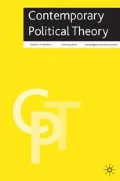Mark Poster Duke University Press, Durham and London, 2006, 303pp. ISBN: 0 8223 3839 4.
Mark Poster's publication of The Mode of Information in 1990 was the start of a major project, still extant, that applied post-structuralism to the study of contemporary media. Though this earlier monograph was a sophisticated critique of the impact of electronic writing on human subjectivity, he could not have envisaged at that time the impact that the World Wide Web (hereafter referred to as ‘the Web’) would have on Media Studies. And, despite the inevitable alterations in perspective brought about by both the reflexivity that all good scholars should practise and the massive cultural change effected by the Web, Poster's work has succeeded in being consistent without losing the flexibility that is needed to make sense of the vicissitudes of modern western society. His latest book, therefore, explores themes familiar to his readers, such as the role of the media in the construction of subjectivity and the significance to society of the proliferation of information. These and other themes are analysed through the use of a series of interesting case studies. Thus, there are chapters on the use of an image of Sesame Street's Bert alongside Osama Bin Laden's face on banners held by protestors in Bangladesh (pp. 9–26), the Teletubbies as symbolic of the fusion of humans and machines (pp. 176–181), and Philip K. Dick's representation of media and advertising in his novel Ubik (pp. 250–267). These serve to demonstrate respectively the effect on national cultures of the deracination of signifiers from their place of initial reception, the increasing importance of what Poster terms ‘humachines’ and the potential of science fiction to offer a vision of a posthuman society.
The latter two examples highlight the most fascinating theme of the whole book. Poster has long held the view that developments in media technology over the past two decades reinforce the ideas of various post-structuralists like Derrida and Foucault. Their notion that language was not a reference to an external reality but constitutive of meaning has been used by theorists of new media — not only by Poster, but also Virilio (2000) and Lash (2002) — to challenge the metaphysical separation of subject and object. This purported loss of human agency and the increasing ubiquity of machines have political consequences:
A critical theory of globalization … to the extent that it explores media, must look not for a revolutionary subject but for a matrix of dispotifs, for a cluster of technologies of power that constructs networked computing and human assemblages [my italics] that might, after they are extensively deployed, act in a fashion that transforms Empire into a planetary system outside the nation-state and capitalist market and toward what might still be labeled [sic] radical democracy (p. 65).
Though he is not cited in the book, this has traces of Bruno Latour's actor-network theory.
However, there is a danger of binding a general theory with the development of a specific medium, and concentrating on aspects of the latter that coincide with rather than stem from post-structuralism. Indeed, while Jacques Derrida's work has been used to justify much cybernetic theory, his pronouncements on the Web were more nuanced:
You find very good and very bad things on these new Web sites. It's a threat — with an ‘anything goes’ bonus. But it is also a chance. … What worries me more than the technology itself in these exchanges is the increasing dominance of one language, and thus of one culture, the Anglo-American (Derrida, 2005, 119).
In other words, much like the modernism of earlier media technologies. A useful antidote to the acceptance by Poster that the Web marks a paradigm shift rather than the latest point on a continuum of various media forms is Siedensticker's Future Hype (2006), which challenges the notion of exponential technological growth and all-pervasive machines.
Where Poster is on surer ground is in his concern that the Web serves to blur the distinction between public and private, thus undermining the public sphere: ‘In a media culture, individuals lose their distance from the public sphere, lose a sense of separateness from objects and events outside themselves, lose cultural distance that is essential to autonomous, ethical judgement’ (p. 148). This can be illustrated by the increasing infantilized nature of our political culture, best exemplified by the comeback of the sex scandal. For around two decades in UK and American politics it has been widely accepted that a politician's private life should not form part of our judgement of his or hers public performance. However, the then nascent Web undoubtedly played a huge role in undermining Bill Clinton's presidency through the posting by the Drudge Report website of intimate details of his affair with Monica Lewinsky. As Poster points out, this constant fear that we are deprived of sufficient amounts of information is shared by people right across the political spectrum. Though Poster does not offer a solution to this seeming compulsion for raw information rather than understanding, we could do worse than heed his call for a new kind of ethics that takes into account the ‘deterritorialization of cultural values’ (p. 160) that the Web promotes.
References
Derrida, J. (trans. By Rachel Bowlby) (2005) Paper Machine, Stanford: Stanford University.
Lash, S. (2002) Critique of Information, London and New Delhi: Thousand Oaks and Sage Publications.
Poster, M. (1990) The Mode of Information: Poststructuralism and Social Context, Chicago: University of Chicago Press.
Seidensticker, R.B. (2006) Future Hype: The Myths of Technology Change, San Francisco: Berrett-Koehler Publishers.
Virilio, P. (trans. by Turner C.) (2000) The Information Bomb, London and New York: Verso.
Author information
Authors and Affiliations
Rights and permissions
About this article
Cite this article
White, A. Information Please. Contemp Polit Theory 6, 500–502 (2007). https://doi.org/10.1057/palgrave.cpt.9300315
Published:
Issue Date:
DOI: https://doi.org/10.1057/palgrave.cpt.9300315

